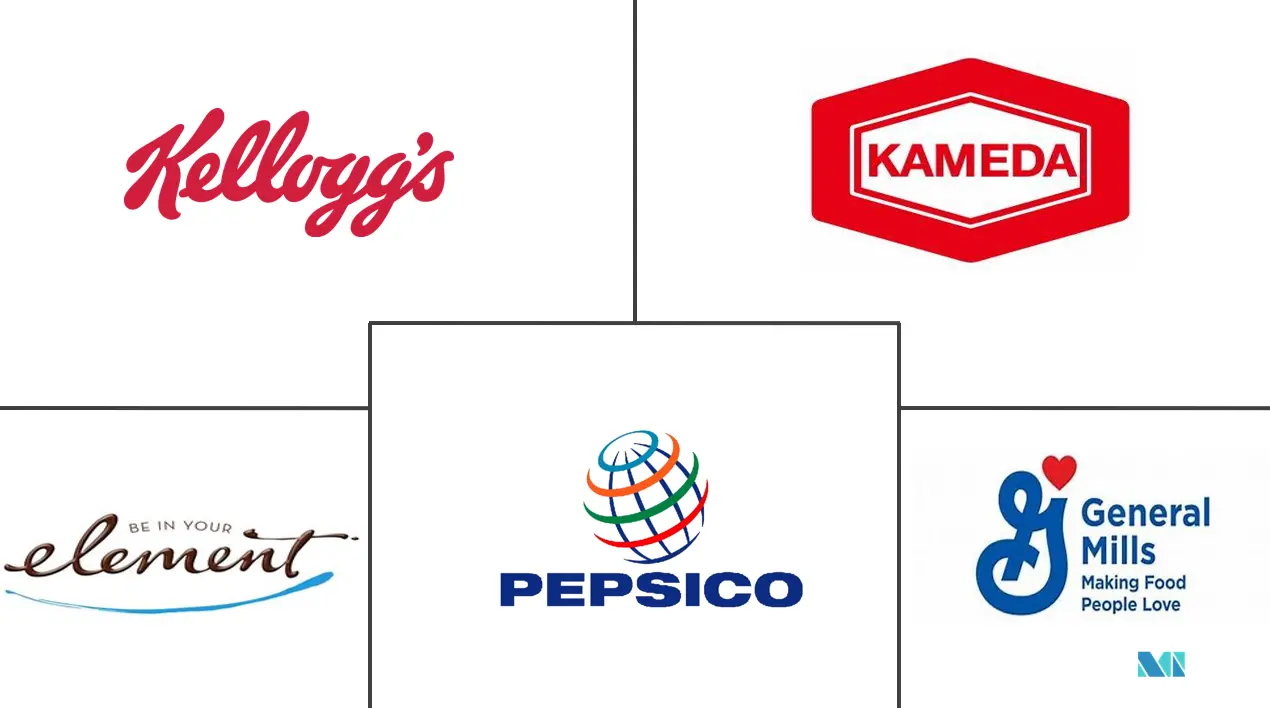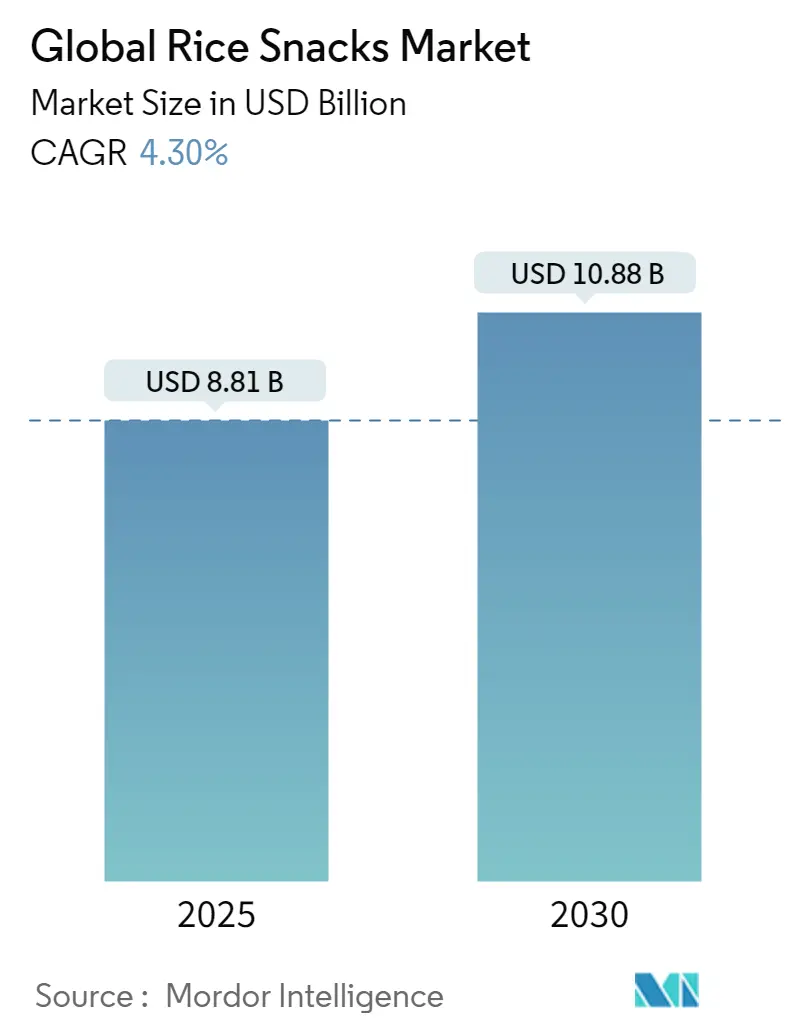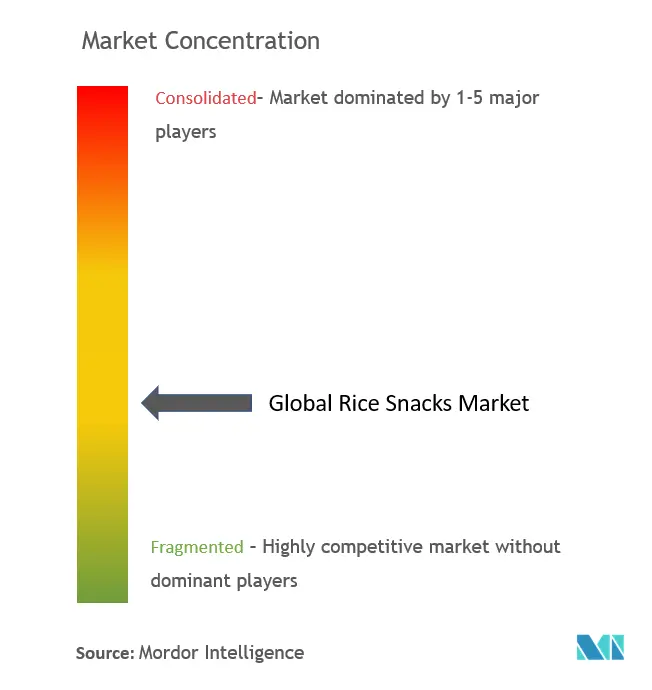Rice Snacks Market Analysis
The Global Rice Snacks Market size is estimated at USD 8.81 billion in 2025, and is expected to reach USD 10.88 billion by 2030, at a CAGR of 4.3% during the forecast period (2025-2030).
Growing consumer health awareness supports the production of nutritious food products. The market for rice-based snacks is expanding in many regions due to changing customer preferences for healthier eating habits. Customers can maintain their hectic lifestyles and work cultures as customers prefer consuming rice-based snacks. Manufacturers prioritize selecting certified, high-quality ingredients. There are numerous target markets for the producers of low-sugar and low-sodium snacks, and as a result of all these factors, the rice snack market is expanding constantly.
The high production of rice grains in Asian nations like China and India, which account for over 40% of the global market, is among the highest. Rice snacks are eaten as breakfast in countries like India. Chivda is the most popular rice snack in India. Rice snacks are consumed among babies and toddlers for better nourishment. The fast-paced lifestyle, the technological improvement and a shift in customer preferences toward healthy snacks, and expanding urbanization in these nations are driving the growth of the rice snack market.
Rice Snacks Market Trends
Increasing Consumer Awareness of the Health Advantages of Rice Snacks products.
The significant trend propelling the market growth for rice snacks is the growing health benefits of rice food products. The wider populace is becoming more health conscious. As a result, the demand for healthy snacks produced with top-notch ingredients is growing. In response to the market, vendors have introduced a range of snacks produced with natural components like rice, which is rich in nutrients. As a result of rising consumer demand for nutritious snacks, the global rice snack market is rapidly growing. Consumers who have digestion-related issues mostly consume rice snack products because rice snacks' high fiber content aids in lowering inflammation, enhancing digestive health, and increasing metabolism. Consumers with diabetes that eat brown rice snacks can help control their blood sugar levels. Moreover, consumers with celiac disorders also prefer rice snacks as they are all gluten-free and thus having access to such nutritious rice snacks is projected to boost market expansion during the forecast period. Rice snacks, regarded as mood stabilizers, can enhance physical and mental health. All these factors highly contribute to the expansion of the rice snacks market.
The Asia Pacific Holds Significant Share in Rice Snacks Market
The rising demand from rice-eating nations like China, Indonesia, Japan, and India, among others, is mainly accountable for the expansion of the rice snacks market in the Asia Pacific region. With an increased demand for rice snacks among the working class people in the Asia Pacific region, the market is anticipated to grow throughout the forecast period. There has been a gentle rise in the consumption and production of convenience foods, such as rice snacks, throughout the Asia Pacific region, and it is expected that this multi-decade trend of expansion would continue gradually. These markets are also being benefited from technology's success. To boost business profits, different retailers in the Asia Pacific sell several varieties of rice snacks under their private-label brands, which is assisting the expansion of the rice snacks industry in the region. Prices for private-label goods are lower compared to branded products. Price-conscious customers thus are more likely to buy such rice snack products. People purchase rice snacks more frequently, whether they are at work, driving, or in a public venue. The consumption of rice snacks has increased in most of the Asia-Pacific region's nations as a result of this fundamental shift in consumer behavior.
Rice Snacks Industry Overview
The Global Rice Snacks Market is competitive. The major players in the rice market are Pepsico Inc, The Kellogg Company, Element Snacks Inc, General Mills Inc, and Kameda Seika Co. Ltd. The market players for rice snacks are concentrating on innovating their products to draw in more customers and provide a distinctive product portfolio. As consumer tastes and preferences change, rice snack manufacturers adapt their offerings. The local companies and startups provide their rice snack product in the local retail channels and on the go. Companies are concentrating on granting certifications. For instance, Pintola offers nutritious ingredients from a factory that is ISO 22000 Certified and FSSAI Approved.
Rice Snacks Market Leaders
-
Pepsico Inc,
-
The Kellogg Company
-
Element Snacks Inc
-
General Mills Inc
-
Kameda Seika Co. Ltd.
- *Disclaimer: Major Players sorted in no particular order
Rice Snacks Market News
In May 2021, The No Nasties Project Cereals launched a rice pop range of naturally sweetened cereals with 50% less sugar. The new cereal intends to change the way Aussies consume breakfast, with no sugar, chemicals, preservatives, colors, or 'nasties'.
In October 2020, The Kellogg company introduced a new rice snack named Rice Krispies Treats HOMESTYLE with marshmallows in original and chocolate flavor. The product is with puffy, oven-toasted rice cereal, soft marshmallows' alluring flavor, and creamy chocolatey flavor.
In January 2020, Kameda (India) Private Limited, and India's largest rice-based food conglomerates, LT Foods Limited, a Joint Venture has launched 'Kari Kari', crunchy, light, healthy, and premium rice snacks in the Indian market.
Rice Snacks Industry Segmentation
A rice snack is a small portion of food eaten between meals. Rice snack is made with whole grain rice. Rice Snacks are being packaged snack foods or other processed foods, among other shapes and sizes. The Rice Snacks Market is segmented by type into rice cakes, rice crisps, rice crackers, and other types. By distribution channel into supermarkets/hypermarkets, convenience stores, online retail stores, and other distribution channels. By geography market is segmented into North America, Europe, Asia-Pacific, South America, and Middle-East and Africa. For each segment, market sizing and forecasts have been done on the basis of value (USD million).
| By Type | Rice Cakes | ||
| Rice Crisps | |||
| Rice Crackers | |||
| Other Types | |||
| By Distribution Channel | Supermarket/Hypermarket | ||
| Convenience stores | |||
| Online Retail Stores | |||
| Other Distribution Channels | |||
| By Geography | North America | United States | |
| Canada | |||
| Mexico | |||
| Rest of North America | |||
| Europe | United Kingdom | ||
| Germany | |||
| Spain | |||
| France | |||
| Italy | |||
| Russia | |||
| Rest of Europe | |||
| Asia-Pacific | China | ||
| Japan | |||
| India | |||
| Australia | |||
| Rest of Asia-Pacific | |||
| South America | Brazil | ||
| Argentina | |||
| Rest of South America | |||
| Middle East & Africa | Saudi Arabia | ||
| South Africa | |||
| Rest of Middle East & Africa | |||
Rice Snacks Market Research FAQs
How big is the Global Rice Snacks Market?
The Global Rice Snacks Market size is expected to reach USD 8.81 billion in 2025 and grow at a CAGR of 4.30% to reach USD 10.88 billion by 2030.
What is the current Global Rice Snacks Market size?
In 2025, the Global Rice Snacks Market size is expected to reach USD 8.81 billion.
Who are the key players in Global Rice Snacks Market?
Pepsico Inc,, The Kellogg Company, Element Snacks Inc, General Mills Inc and Kameda Seika Co. Ltd. are the major companies operating in the Global Rice Snacks Market.
Which is the fastest growing region in Global Rice Snacks Market?
North America is estimated to grow at the highest CAGR over the forecast period (2025-2030).
Which region has the biggest share in Global Rice Snacks Market?
In 2025, the Asia-Pacific accounts for the largest market share in Global Rice Snacks Market.
What years does this Global Rice Snacks Market cover, and what was the market size in 2024?
In 2024, the Global Rice Snacks Market size was estimated at USD 8.43 billion. The report covers the Global Rice Snacks Market historical market size for years: 2019, 2020, 2021, 2022, 2023 and 2024. The report also forecasts the Global Rice Snacks Market size for years: 2025, 2026, 2027, 2028, 2029 and 2030.
Our Best Selling Reports
Global Rice Snacks Industry Report
The Rice Snacks Market is segmented by type into rice cakes, rice crisps, rice crackers, and other types. The distribution channels include supermarkets/hypermarkets, convenience stores, online retail stores, and other distribution channels. The geographical segmentation covers North America, Europe, Asia-Pacific, South America, and the Middle-East and Africa. The report provides market sizes and forecasts in USD million for these segments.
The global market for rice snacks shows significant market growth, driven by changing consumer preferences and increasing demand for healthier snack options. The market size and market share are analyzed across various regions, providing a comprehensive market overview. The market analysis highlights key market trends and market growth factors that are influencing the industry.
Industry reports and industry analysis offer insights into the market forecast and industry outlook, helping stakeholders understand the market dynamics. The market leaders are identified, providing a clear picture of the competitive landscape. Market segmentation is detailed, showing the distribution of market value among different segments.
The report example includes industry information and industry statistics, which are crucial for understanding the market trends. Market data is presented in a clear and concise manner, making it easy for readers to grasp the market predictions and market review.
This industry research is vital for companies looking to enter the rice snacks market or expand their market presence. The report pdf is available for download, providing a comprehensive industry overview. Research companies can use this report to gain insights into market segmentation and market value, aiding in strategic decision-making.
Overall, the report offers a thorough market outlook and industry sales forecast, supported by detailed industry research. The market forecast provides a long-term view of the market growth, helping stakeholders plan for the future. The industry trends and market data included in the report are essential for understanding the current state and future potential of the rice snacks market.







